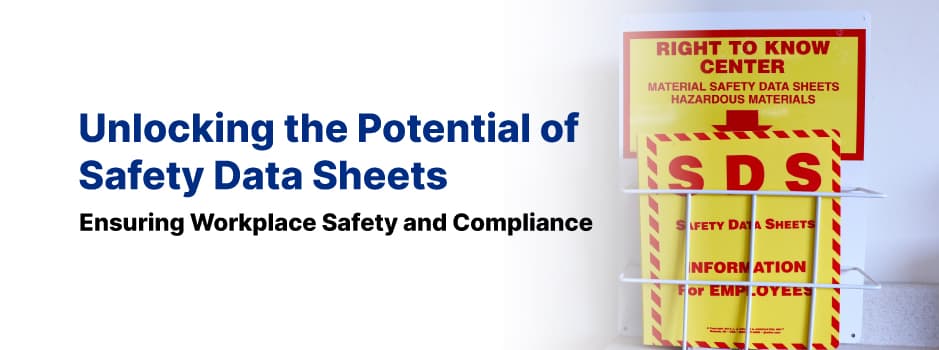Safety Data Sheets (SDS) are an essential tool in ensuring a safe and compliant workplace. They provide vital information on hazardous substances and chemicals, allowing employees and employers to take the necessary precautions in handling, storing, and disposing of these materials. Despite their significance, the potential of SDSs is often underutilized. This comprehensive article aims to explore the numerous ways in which SDSs can be useful at the workplace, and how employers and employees alike can optimize their use for improved safety and compliance.
Understanding the Purpose and Structure of Safety Data Sheets
SDSs are a crucial component of the globally harmonized system (GHS) of classification and labeling of chemicals. They are designed to standardize the communication of chemical hazards, enabling businesses and workers to take the necessary precautions when handling chemicals. Each SDS is organized into 16 sections that cover a range of information, including:
- Identification: Chemical product and company details
- Hazards identification: Classification of hazards and warning labels
- Composition/information on ingredients: Chemical components and concentrations
- First-aid measures: Emergency treatment instructions
- Fire-fighting measures: Suitable extinguishing agents and equipment
- Accidental release measures: Containment and cleanup procedures
- Handling and storage: Precautions for safe handling and storage conditions
- Exposure controls/personal protection: Recommendations for protective gear and exposure limits
- Physical and chemical properties: Characteristics of the substance
- Stability and reactivity: Reactivity hazards and conditions to avoid
- Toxicological information: Health effects and symptoms of exposure
- Ecological information: Environmental impact and precautions
- Disposal considerations: Safe disposal methods and regulations
- Transport information: Shipping classifications and requirements
- Regulatory information: Applicable safety, health, and environmental regulations
- Other information: Additional safety and handling information
Ensuring Accessibility and Comprehension
To maximize the usefulness of SDSs, employers must ensure that they are readily accessible to all employees. This can be achieved by:
- Maintaining an organized and up-to-date SDS library, both in physical and digital formats
- Providing training to employees on locating and interpreting SDSs
- Establishing a designated SDS coordinator to oversee the management and updating of SDSs
- Implementing an SDS management system to track and maintain SDSs, as well as monitor regulatory changes
Incorporating SDSs into Risk Assessments and Standard Operating Procedures
Employers should integrate SDS information into risk assessments and standard operating procedures (SOPs) to improve workplace safety. This involves:
- Analyzing the hazards identified in SDSs and determining the appropriate control measures
- Developing SOPs based on SDS information to ensure the safe handling, storage, and disposal of chemicals
- Regularly reviewing and updating risk assessments and SOPs to reflect changes in SDS information or workplace conditions
Enhancing Employee Training and Awareness
In addition to ensuring accessibility, employers should incorporate SDS information into employee training programs to improve overall safety awareness. Training should include:
- Familiarizing employees with the structure and content of SDSs
- Teaching employees how to identify and interpret hazard symbols and statements
- Demonstrating the proper use of personal protective equipment (PPE) and other safety measures outlined in SDSs
- Providing practical, hands-on training for handling, storing, and disposing of hazardous chemicals
Ensuring Compliance with Local and International Regulations
SDSs play a crucial role in complying with various safety and environmental regulations. Employers should:
- Regularly review SDSs to ensure compliance with local, national, and international regulations
- Update and maintain SDSs according to changing regulatory requirements
- Train employees on the importance of adhering to the information and recommendations provided in SDSs to meet regulatory obligations
Implementing Emergency Response Plans
SDSs contain critical information for responding to emergencies involving hazardous substances. Employers should use this information to develop comprehensive emergency response plans by:
- Identifying potential emergency scenarios based on the hazards outlined in SDSs
- Establishing clear procedures for each scenario, including evacuation routes, containment, and cleanup measures
- Training employees on emergency response procedures and conducting regular drills to ensure preparedness
- Coordinating with local emergency services and sharing relevant SDS information to facilitate a rapid and effective response
Facilitating Hazard Communication with Suppliers and Customers
SDSs are valuable tools for communicating chemical hazard information throughout the supply chain. Employers can use SDSs to:
- Evaluate the safety and compliance of materials received from suppliers
- Communicate with suppliers to request updated SDSs or clarify hazard information
- Share relevant SDS information with customers to ensure their safe handling and use of products
Promoting a Culture of Safety
Incorporating SDSs into workplace safety practices and policies can help promote a culture of safety among employees. This can be achieved by:
- Encouraging open communication and feedback on SDSs and workplace safety
- Recognizing and rewarding employees who actively contribute to improving safety and compliance
- Empowering employees to voice concerns or report potential hazards, based on their understanding of SDS information
Conclusion
Safety Data Sheets are indispensable tools for ensuring a safe and compliant workplace. By understanding their purpose and structure, ensuring accessibility and comprehension, incorporating SDS information into risk assessments and SOPs, enhancing employee training, ensuring compliance with regulations, implementing emergency response plans, facilitating hazard communication, and promoting a culture of safety, employers and employees can unlock the full potential of SDSs to protect themselves, their colleagues, and the environment from harm. With a proactive approach to SDS management and utilization, workplaces can minimize risks associated with hazardous chemicals and foster a safer, healthier, and more productive work environment.

